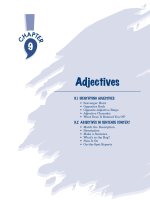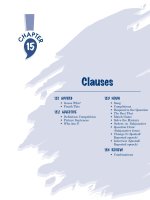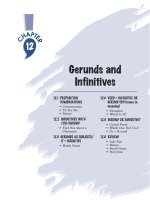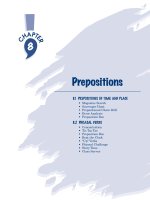fun With Grammar - Adjectives
Bạn đang xem bản rút gọn của tài liệu. Xem và tải ngay bản đầy đủ của tài liệu tại đây (240.72 KB, 19 trang )
Adjectives
9
9.1 IDENTIFYING ADJECTIVES
• Scavenger Hunt
• Opposites Book
• Opposite-Adjective Bingo
• Adjective Charades
• What Does It Remind You Of?
9.2 ADJECTIVES IN SENTENCE CONTEXT
• Match the Description
• Description
• Make a Sentence
• What’s in the Bag?
• Pass It On
• On-the-Spot Reports
9.1 IDENTIFYING ADJECTIVES
1. SCAVENGER HUNT
Materials:
Magazines to share
Dynamic:
Groups
Time:
15 minutes
Procedure:
1. On the board, write a list of items you want the students to find a
picture of. Each item should include an adjective and noun.
Examples: a happy person an angry person
a sad person an unusual person
a crying baby a crazy person
2. Divide the class into groups of three or four and give each group a
couple of magazines (or assign each student to bring in a magazine
as the previous night’s homework). Another method of distributing
magazines is to keep a pile of magazines on a table and restrict
each group to two magazines at a time. In order to get a new
magazine, they must trade in one of their two. In this way, the
students are not limited to one or two magazines that may not
have good pictures in them, but at the same time, they cannot
“hog” a pile of magazines.
3. The students cut out the pictures so they can show them to the
other groups. You may want them to paste the pictures on paper,
hold them up, or arrange them on their desks or a table. The
students would then circulate to look at them.
4. You may want the groups to vote on which picture is the best
example for each item. These could then be put together on a poster.
2. OPPOSITES BOOK
Materials:
Magazines or catalogs, construction paper
Dynamic:
Individuals/Pairs
Time:
30 minutes
Procedure:
1. Have students bring in magazines or catalogs to cut up in class. Be
sure there are plenty for them to use. In their magazines, students
look for pictures of opposites, cut them out, and paste each picture
on a separate page. They then label the picture with the adjective
it depicts. (One page might have a picture of someone who is angry,
and the next page have someone looking happy, for example.)
178
179
2. When they have found as many opposites as possible or when time
is up, the students staple the pages together into an “Opposites
Book.”
3. The students can then exchange books to look at the pictures other
students have found to depict opposite adjectives.
SUGGESTION: You can give the students free rein to choose the
opposite adjectives they want, or you can give them a list to find.
The students can easily find pictures of these adjectives.
comfortable/uncomfortable common/uncommon
bad/good happy/sad
healthy/sick important/unimportant
interesting/uninteresting (boring) beautiful/ugly
necessary/unnecessary clean/dirty
pleasant/unpleasant polite/impolite
big/small cheap/expensive
cold/hot dangerous/safe
dark/light dry/wet
empty/full fast/slow
fat/thin hard/soft
heavy/light long/short
messy/neat modern/old-fashioned
noisy/quiet old/young
sour/sweet strong/weak
Variation:
By labeling the pictures, the students create a study book for
themselves. For a more interactive activity, before they label the
pictures, the students can exchange books with a classmate and have
the classmate try to supply the adjectives.
3. OPPOSITE-ADJECTIVE BINGO
Materials:
A bingo board (Worksheet 55A, 55B, or 55C)
for each student, markers
Dynamic:
Whole class
Time:
15 minutes
Procedure:
1. Give each student a bingo board and markers to cover the words
(paper squares, tiles, beans, etc.). You may want to give them time to
look over the words on the board. Explain that when you call out an
adjective, they are to look for and cover up that adjective’s opposite.
For example, if you call out “hard,” the students cover up “soft.”
2. The first person who covers five adjectives in a row is the winner.
Check the answers. If the student has made a mistake, continue the
game. (For variation, you could allow four corners or a cross, etc.)
Variations:
Give everyone the same board so they will all hit bingo at the same
time. Or make your own from the blank board (Worksheet 55D). You
might also give the students blank boards and write a list of adjectives
on the board. The students then choose from that list to fill in their
boards in any order they want. Since the words you call off will be
related to the words you write on the board, the students cannot write
in their own adjectives.
4. ADJECTIVE CHARADES
Materials:
Worksheet 56, cut up
Dynamic:
Teams
Time:
20 minutes
Procedure:
1. Cut Worksheet 56 into pieces and keep them in a hat, box, or bag.
Divide the class into teams.
2. A student from the first team draws a slip with an adjective on it
and must act out the adjective for his/her teammates. Set a time
limit. If the team does not guess it, the other team (or teams) has
a chance to “steal” the answer.
3. Give a point to the team if it guesses correctly in the time limit, or
to the team that steals the answer. Play then passes to the next
team. Continue until all slips have been played or until the time
limit is reached.
5. WHAT DOES IT REMIND YOU OF?
Materials:
Worksheet 57
Dynamic:
Groups
Time:
20 minutes
Procedure:
1. Divide the students into groups of four. Give each student a copy of
the handout and have everyone fill in the chart under “you” with a
place, person, or thing that the adjectives remind him/her of.
2. Have each student take turns asking the other three members of
the group what the adjectives remind them of. The students then
record this information on their charts.
3. Compare charts as a class by asking who had the same ideas in
their group, who gave an unusual or funny answer, etc.
180
181
9.2 ADJECTIVES IN SENTENCE CONTEXT
1. MATCH THE DESCRIPTION
Materials:
Worksheets 58A and 58B or your own cards
Dynamic:
Whole class
Time:
30 minutes
Procedure:
1. Give each student two cards: one with a description of themselves
(Worksheet 58A, cut up) and the other of a description of the
classmate they are supposed to find (Worksheet 58B, cut up). Each
student assumes the identity of his/her description from
Worksheet 58A.
2. The students may not look at anyone’s A card. They must circulate
and ask each other questions based on the description of the
person they are looking for.
Example: If John’s B card says “Find someone who is tall and
thin and wearing a basketball uniform,” John must
ask other students questions to find that person. (“Are
you tall?” “What are you wearing?”)
At the same time, the other students will be asking questions to
match their B cards. John should be prepared to look at his A card
to answer questions addressed to him even when he is finished
asking questions.
3. When a match is made, the student with the B card takes the other
student’s A card. The students do not sit down until they have both
given up their A card and received another student’s A card.
4. When everyone has finished, you can ask some questions: “Who is
tall and wearing a basketball uniform?” “Who has short curly
blond hair?” “Who is handicapped?”
Variation:
For a less complicated game, keep the B cards but use small pictures
from a magazine instead of A cards. When a match is made, the person
with the description card takes the picture card.
2. DESCRIPTION
Materials:
None
Dynamic:
Whole class
Time:
15 minutes
Procedure:
1. Have each student write a one-sentence description of a classmate
on a piece of paper, using at least one adjective in the description.
Example: She has long curly hair.
He is wearing a black leather jacket.
She has on a colorful T-shirt.
2. The students take turns reading the descriptions aloud. The rest of
the class tries to guess who is being described.
NOTE: Because students are competing to guess the identity of their
classmates, caution them not to be too general (not “She is wearing
dark blue jeans” if most of the class is wearing dark blue jeans) or
too specific (not “She is wearing a T-shirt with a purple-and-yellow-
striped zebra on it.”). Descriptions that are too general result in a
simple guessing game. Descriptions that are too specific take the
fun out of the game.
3. MAKE A SENTENCE
Materials:
Worksheet 59
Dynamic:
Groups
Time:
20 minutes
Procedure:
1. Arrange the class in groups of approximately four. Give the cards
from one cut-up worksheet to each group, face down. Tell the
students to deal out five cards per person and keep the others face
down in a pile.
2. The students take turns choosing a card either from the pile or
from another student’s hand, and then discarding. The object is to
make a complete sentence with an adjective in it.
3. When one of the players has a complete sentence in his/her hand,
he/she displays the sentence in order. All the cards in the student’s
hand must be used to make the sentence. If it is accepted by the
group (you can intervene as ultimate judge), the game is over and
that student is the winner. If the sentence does not make sense, is
not grammatically constructed, or contains no adjective, the
student picks up his/her cards and the play resumes.
182
183
While the words on the worksheet are arranged into four-word
sentences, it is possible for the students to come up with other
possibilities using the words on the worksheet. As long as the
students are able to produce a logical sentence of the correct
length, accept their answer.
NOTE: If you are making your own cards instead of or in addition
to using the worksheet, be sure all sentences are of equal length.
4. WHAT’S IN THE BAG?
Materials:
5–12 small paper bags
items for the bags
Dynamic:
Pairs/Whole class
Time:
20 minutes
Procedure:
1. Place one item in each bag. You may want to use multiple pieces of
one item, such as seven cotton balls or a handful of pot pourri.
Suggested items:
cooked pasta dry, broken pasta pot pourri
cotton balls flour soil
croutons paper clips
2. Put a list of adjectives on the board. The words will depend on the
level of your class. For example:
Beginner: round, hard, soft, long, small, large
Intermediate: sharp, sandy, sweet-smelling, sour, flexible
Advanced: sticky, rubbery, pliable, brittle, pungent, odorous
3. Using an adjective order chart such as the one in Basic English
Grammar, have students generate words from each adjective
category (opinion adjectives, colors, sizes, etc.). Introduce new
words in each of these categories and write them on the board.
4. Arrange students into pairs and assign each pair a number. Have
each pair write its number on the outside of its bag.
5. The students feel the contents of the bag and then write adjectives
on the outside of the bag describing what they feel. Ask students
to draw from the words on the board.
6. Students pass the bags around so everyone can experience the
contents of each bag. Then have the pairs generate a sentence using
adjectives to describe the contents of the bag they are holding.
7. From the description, the other students try to guess the contents
of the bag. You can have the other pairs call out their guesses, or
for a competition, have each pair write down its guesses, exchange
papers, and show the class the contents to correct the papers.









